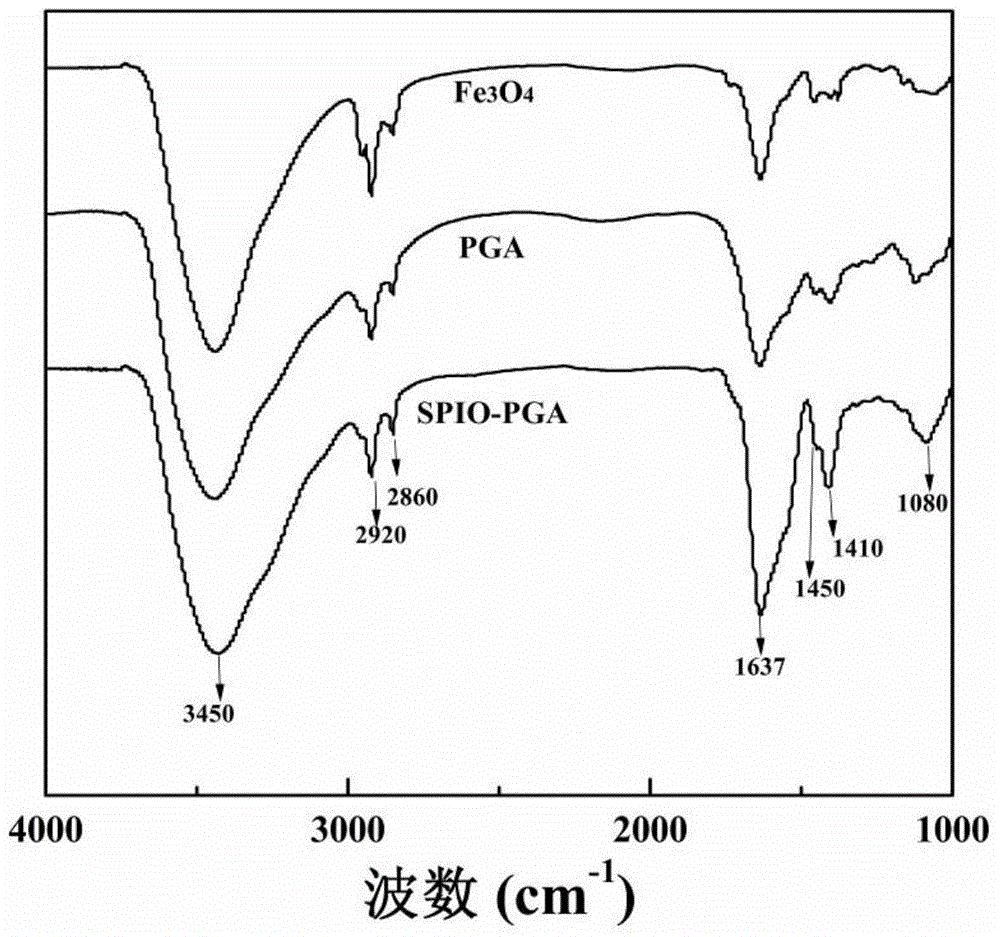Preparation method of polyglutamic acid PGA-coated superparamagnetic iron oxide nanoparticle
A technology of iron oxide nanometer and polyglutamic acid, which is applied in the preparations and pharmaceutical formulations for in vivo experiments, can solve the problem of not finding SPIO nanoparticles, and achieve a remarkable contrast effect, good water solubility, and low raw material cost. Effect
- Summary
- Abstract
- Description
- Claims
- Application Information
AI Technical Summary
Problems solved by technology
Method used
Image
Examples
Embodiment 1
[0062]Dissolve 640mg of ferric chloride hexahydrate in 50mL of ultrapure water, blow in nitrogen gas for 10 minutes and stir thoroughly. Dissolve 90 mg of PGA in 20 mL of ultrapure water, and add the above solution dropwise. After stirring evenly, add 9mg / mL sodium sulfite solution dropwise. Transfer the mixed solution to a 60°C water bath, add 1 mL of ammonia water, and fully react for 30 minutes. The mixed solution was moved to room temperature, and the reaction was continued for 1.5 hours. The prepared solution was centrifuged at a speed of 8000 rpm for 10 minutes, the centrifuged precipitate was discarded, and the upper layer solution was taken. Dialyze with a dialysis bag with a molecular weight cut off of 8000-14000. The dialysis water was distilled water, and the dialysis was carried out for three days, and the water was changed three times a day. The iron ferric oxide nanoparticles coated with polyglutamic acid prepared by the present invention are observed by tran...
Embodiment 2
[0064] The concentration of Fe element in the SPIO-PGA nanoparticle solution prepared by the present invention is determined by ICP-OES test method. Prepare 2 mL of SPIO-PGA nanoparticle aqueous solutions with Fe concentrations of 0.004, 0.008, 0.016, 0.032, and 0.064 mM, and measure the T of the material at different Fe concentrations by a magnetic resonance imaging analyzer. 2 relaxation effect (see attached Figure 5 ). The results of relaxation rate test show that the reciprocal of relaxation time of SPIO nanomaterials has a good linear relationship with the increase of iron concentration (within the concentration range of 0.004-0.064mM). The r of the SPIO-PGA prepared by the present invention can be obtained by calculation 2 Relaxation rate up to 333.7mM -1 the s -1 . Therefore, the SPIO-PGA prepared by the present invention can be used as an excellent T 2 Signal attenuating contrast agents.
Embodiment 3
[0066] HeLa cells were used as model cells to evaluate the effect of SPIO-PGA nanoparticles prepared by the present invention on cell viability. Bare Fe prepared in Comparative Example 1 3 o 4 Nanoparticles served as controls. The solution obtained in Example 1 was sequentially prepared into physiological saline solutions (sodium chloride content 0.9%) with Fe element concentrations of 50, 150, 250, 350, 450 μg / mL SPIO-PGA nanoparticles. HeLa cells were planted in a 96-well plate, and 5 parallel samples were set for each concentration, and the cell culture plate was placed in CO 2 The concentration was 5% and the temperature was 37° C. for 24 hours. After MTT treatment, the absorbance value of each well at λ=570nm was detected on a microplate reader, and the corresponding cell viability was calculated accordingly. The cells treated with normal saline were used as the blank control, and the cell viability was recorded as 100%. compared with control exposed Fe 3 o 4 In con...
PUM
| Property | Measurement | Unit |
|---|---|---|
| Relaxation rate | aaaaa | aaaaa |
Abstract
Description
Claims
Application Information
 Login to View More
Login to View More - Generate Ideas
- Intellectual Property
- Life Sciences
- Materials
- Tech Scout
- Unparalleled Data Quality
- Higher Quality Content
- 60% Fewer Hallucinations
Browse by: Latest US Patents, China's latest patents, Technical Efficacy Thesaurus, Application Domain, Technology Topic, Popular Technical Reports.
© 2025 PatSnap. All rights reserved.Legal|Privacy policy|Modern Slavery Act Transparency Statement|Sitemap|About US| Contact US: help@patsnap.com



